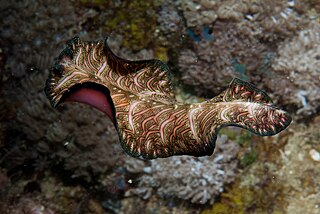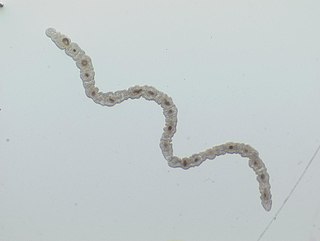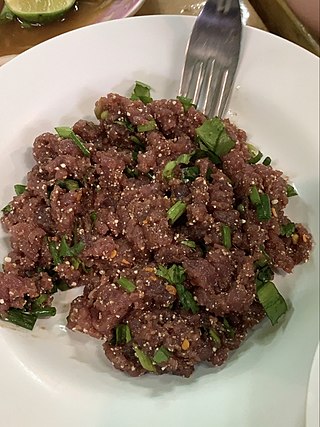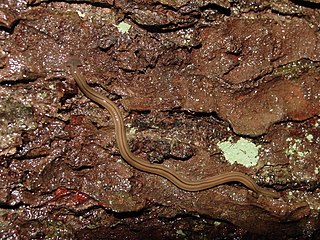| Bothrioneodermata | |
|---|---|
| Scientific classification | |
| Domain: | Eukaryota |
| Kingdom: | Animalia |
| Phylum: | Platyhelminthes |
| Clade: | Acentrosomata |
| Clade: | Bothrioneodermata |
Bothrioneodermata is a clade of flatworms containing the Bothrioplanida and the Neodermata. [1]
| Bothrioneodermata | |
|---|---|
| Scientific classification | |
| Domain: | Eukaryota |
| Kingdom: | Animalia |
| Phylum: | Platyhelminthes |
| Clade: | Acentrosomata |
| Clade: | Bothrioneodermata |
Bothrioneodermata is a clade of flatworms containing the Bothrioplanida and the Neodermata. [1]

The flatworms, flat worms, Platyhelminthes, or platyhelminths are a phylum of relatively simple bilaterian, unsegmented, soft-bodied invertebrates. Unlike other bilaterians, they are acoelomates, and have no specialised circulatory and respiratory organs, which restricts them to having flattened shapes that allow oxygen and nutrients to pass through their bodies by diffusion. The digestive cavity has only one opening for both ingestion and egestion ; as a result, the food cannot be processed continuously.

Bilateria is a large clade/infrakingdom of animals called bilaterians, characterized by bilateral symmetry during embryonic development. This means their body plans are laid around a longitudinal axis with a front and a rear end, as well as a left–right–symmetrical belly (ventral) and back (dorsal) surface. Nearly all bilaterians maintain a bilaterally symmetrical body as adults; the most notable exception is the echinoderms, which achieve secondary pentaradial symmetry as adults, but are bilaterally symmetrical as an embryo. Cephalization is also a characteristic feature among most bilaterians, where the special sense organs and central nerve ganglia become concentrated at the front/rostral end.

Orthonectida is a small phylum of poorly known parasites of marine invertebrates that are among the simplest of multi-cellular organisms. Members of this phylum are known as orthonectids.

Planarians (triclads) are free-living flatworms of the class Turbellaria, order Tricladida, which includes hundreds of species, found in freshwater, marine, and terrestrial habitats. Planarians are characterized by a three-branched intestine, including a single anterior and two posterior branches. Their body is populated by adult stem cells called neoblasts, which planarians use for regenerating missing body parts. Many species are able to regenerate any missing organ, which has made planarians a popular model in research of regeneration and stem cell biology. The genome sequences of several species are available, as are tools for molecular biology analysis.

Acoelomorpha is a subphylum of very simple and small soft-bodied animals with planula-like features which live in marine or brackish waters. They usually live between grains of sediment, swimming as plankton, or crawling on other organisms, such as algae and corals. With the exception of two acoel freshwater species, all known acoelomorphs are marine.

Pseudocerotidae is a family of flatworms which includes the Bedford's flatworm. Pseudocerotidae are simple organisms categorized by their oval bodies and tentacles and bright colors. They use the cilia to glide along surfaces. Most commonly referred to as marine flatworms, closely related to the orders Macrostomorpha and Lecithoepitheliata. These organisms have very complex reproductive systems, no blood systems or organs for gas exchange, a simple brain and are hermaphroditic.

Geoplanidae is a family of flatworms known commonly as land planarians or land flatworms.

Protostomia is the clade of animals once thought to be characterized by the formation of the organism's mouth before its anus during embryonic development. This nature has since been discovered to be extremely variable among Protostomia's members, although the reverse is typically true of its sister clade, Deuterostomia. Well known examples of protostomes are arthropods, molluscs, annelids, flatworms and nematodes. They are also called schizocoelomates since schizocoely typically occurs in them.

Bipalium is a genus of large predatory land planarians. They are often loosely called "hammerhead worms" or "broadhead planarians" because of the distinctive shape of their head region. Land planarians are unique in that they possess a "creeping sole", a highly ciliated region on the ventral epidermis that helps them to creep over the substrate. Native to Asia, several species are invasive to the United States, Canada, and Europe. Some studies have begun the investigation of the evolutionary ecology of these invasive planarians.

Platydemus manokwari, also known as the New Guinea flatworm, is a species of large predatory land flatworm.

The Lecithoepitheliata are an order of rhabditophoran flatworms. They are free-living worms, found in freshwater, soil, and marine environments. However, it is still poorly known their roles in the natural food web.

Catenulida is an order of flatworms in the classical classification, or a class of flatworms in a phylogenetic approach. They are relatively small free-living flatworms, inhabiting freshwater and marine environments. There are about 100 species described worldwide, but the simple anatomy makes species distinction problematic.

Girardia is a genus of freshwater planarians belonging to the family Dugesiidae.

Koi is a "salad" dish of the Lao people living in modern-day Laos and Isan, Thailand, consisting of raw meat denatured by acidity, usually from lime juice. Common varieties include koi kung, with shrimp as the main ingredient, and koi paa /koi pla, which consists of minced or finely chopped raw fish in spicy salad dressing.
Neoophora is a group of rhabditophoran flatworms with ectolecithal eggs, i.e., yolk is not present in the egg as in most animals, but rather is secreted by accessory glands called vitellaria or yolk glands. These glands have the same embryonic origin as the ovaries, but usually constitute a separate organ in adult animals.

Bipaliinae is a subfamily of land planarians found mainly in Madagascar, the Indian subcontinent and Southeast Asia, although some species have been introduced worldwide.

Neodermata is a clade of rhabditophoran flatworms containing the parasitic groups Trematoda, Monogenea and Cestoda.
Rhabditophora is a subphylum of flatworms. It includes all parasitic flatworms and most free-living species that were previously grouped in the now obsolete class Turbellaria. Therefore, it contains the majority of the species in the phylum Platyhelminthes, excluding only the catenulids, to which they appear to be the sister group.
The echinoderm and flatworm mitochondrial code is a genetic code used by the mitochondria of certain echinoderm and flatworm species.

Trepaxonemata is a subclass of the Platyhelminthes or flatworms. It includes all parasitic flatworms and several free-living species that were previously grouped in the now obsolete class Turbellaria. Therefore, it contains the majority of species in the phylum Platyhelminthes, excluding the Catenulida, and the Macrostomorpha.